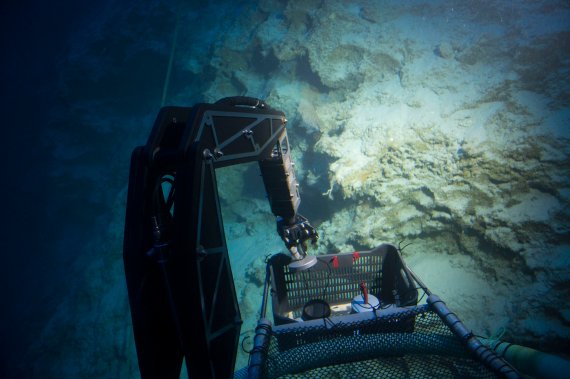Photo: Martijn Visser. Sediment samples are taken at great depth using a hydraulic arm.
The average depth of the ocean is 3700 metres and in some places it is up to 10 kilometres deep. Which makes the 300 metres to which Martijn Visser (Master’s student of Forest & Nature Conservation) dived for his thesis research off Curacao look like child’s play. ‘That is just where the ocean starts getting deep, and yet it’s ten times the Forum. It took 45 minutes to get down to that depth.’
The first time he went down to 300 metres was an extraordinary experience, says Visser, who is an experienced diver. ‘I had seen films on the internet beforehand which I loved, but diving yourself is really thrilling. You slide downwards over the reef, and you see fish, little crabs and all sorts of creatures. There is less and less light until it’s totally dark. When the lights of the submarine switch on you see that there is still life down there, but different species to those in shallow waters, such as colourless fish.’ The only noise was that of the submarine. ‘And of the big hydraulic arms we used to take soil samples. They made a lot of noise.’
Environmental disaster
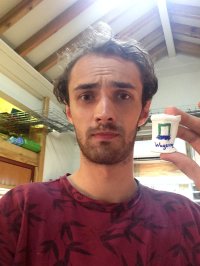
Martijn attached a coffee cup to the outside of the submarine, to see how the high pressure affects it.
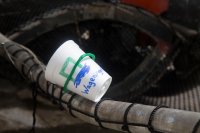
How does a Master’s student from Wageningen end up in a submarine owned by someone from Curacao? Visser: ‘I was one of the students on Team REEFolution, which won a prize last year for an idea for restoring the Thai island of Koh Tao in a sustainable and attractive way.’ For that project he talked to Tinka Murk, professor in the Marine animal ecology chair group and chair of a foundation that also works on restoring coral reefs. She ended up not only adopting the name REEFolution but also involving Visser in one of her marine projects.
It is a tight squeeze in there but you don’t complain because you are in a real submarine
Visser: ‘Tinka Murk thinks there is a close relation between the deep-sea ecosystem and the ecosystem in shallower waters.’ As an example Visser mentions the disaster of Deepwater Horizon, a drilling platform that blew up and sank off the southern coast of the United States in 2010. Millions of litres of oil poured into the Gulf of Mexico in the worst oil spill in the history of the United States. ‘Chemicals were used to break up the oil on the water surface into little pieces, as it were, and make it sink. At a depth of 1500 metres there is now an enormous amount of muck and oil so that life is hardly possible there anymore. That has probably had an impact on life in shallower waters too. One theory is, for example, that there are fewer red snappers since the disaster. The larvae these fish live on normally come up to the surface from greater depths, and now there aren’t any.’
Biomass reservoir
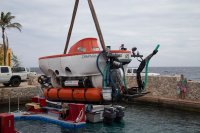
The Curacao mini-submarine with which Martijn Visser dived to 300 metres.
Besides a major environmental disaster of this kind, climate change or overfishing can have a long-term impact on the various deep-sea ecosystems too. But we do not know for sure, says Visser. ‘The deep sea is the biggest biomass reservoir in the world, but we know relatively little about it. Many cycles bring sinking nutrients back to the surface and everything that falls to the seabed gets converted into other substances by little organisms. My research is about those little organisms on the seabed, meiofauna. This is just one of the pieces of the puzzle which can teach us a bit more about deep-sea life.’
Early in April Visser travelled to Curacao, where Tinka Murk knew the owner of a mini-submarine who took rich tourists on dives for about 650 dollars a trip. He was willing to deploy his vessel in the service of science as well. Visser dived three times in total, together with the skipper and the driver of the hydraulic arm. ‘It was a tight squeeze: the two of us lay for three hours on benches of sorts, with the captain behind us. At some point you start getting aches and pains, but you don’t complain because you are in a real submarine.’
New species
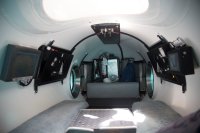
Martijn: ‘It was a tight squeeze in the mini-submarine: for three hours the two of us lay on benches of sorts.’
Visser took sediment samples at a range of depths. ‘We had made instruments for doing that ourselves in advance. We didn’t have the money or the knowledge to buy really good equipment, so it was all a bit makeshift.’ On the first dive, for example, they used coffee tins from the supermarket, but they got crushed by the hydraulic arm. The second and third attempts, using PVC cans and a lid with a spring, went better. In total Visser got 120 sediment samples from various depths, some of them by diving himself.
He put the samples under a microscope at the CARMABI research station on the island. ‘As far as possible I tried to identify the meiofauna to the family level, but in a couple of cases I have no idea which family they belong to. The chances are that I’ve found an as yet unidentified species, given that there has been so little research on this. If that is the case, the credit goes to the person who identifies it as a new species, and that is an expert at Naturalis in Leiden, Wageningen’s partner in this project.’
Titanic
Visser will be using the coming month to round off his research. After that he still has two courses and an internship to do. ‘For that I really want to do something that is of social relevance. What I did in the submarine was pure ecology. You increase your scientific knowledge, but it’s not obvious initially what you gain by it. That doesn’t change the fact that it was a great experience, which I enjoyed and learned a lot from. But I don’t feel the urge now to go even deeper in the ocean. Crewed submarines can go to the greatest depth. But the only people who’ve actually done it are the director of the film Titanic, James Cameron, and two crazies a long time ago.’

